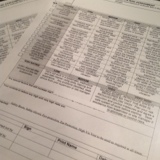Information
-
Client
-
Location
-
Conducted on
-
Duration of work activity
-
Activity covered by this assessment
- Electrical work up to 415 Volts
-
Circumstances which will require additional assessment
- Any work on circuits involving voltages in excess of 415 Volts
- Any work on equipment which may be energised by third parties
1. Working at Heights
-
1.1. Fall risks of 2m or more? (including voids, pits, and trenches)
2. Tools and Equipment
-
2.1. Unsafe or damaged tools/equipment? (including missing or damaged guards, electrical test leads etc)
-
2.2. Incorrect tools /equipment for job? (e.g. Non insulated screwdrivers etc)
-
2.3 Power tools appliance tested.
-
2.4. Test meters calibrated?
3. Loft spaces
-
3.1. Safe and secure access to the loft (i.e loft ladder or extendable ladder safety positioned)
-
3.2. Loft has adequate flooring to work in or a crawl board in place where work is to take place
-
3.3 Adequate lighting in place to avoid addition risk of injury
4. Other people and animals (pets) at the property
-
4.1. Customer and other adult occupants aware of the work area and agree to avoid entering it until work area is cleared away?
-
4.2. Children and other vulnerable people under due care from a competent adult and restricted from entering the work zone
-
4.3. Support systems in place for unsupervised vulnerable people. (i.e. heating kept on for elderly person, emergency call phone line still attached)
-
4.4. Approved warning and health and safety signs on display in a prominent area?
5. Noise
-
5.1. All occupants of the property protected from noise above 83dB(A)
6. Ladders
-
6.1. Unsafe or damaged ladders?
-
6.2. Unsafe positioning of ladders?
-
6.3. Ladder not properly secured?
-
6.4. Ladder unsuitable for job? (e.g. Step ladder used for accessing loft spaces)
7. Work area and manual Tasks
-
7.1. Risk of exposure to live electrical contact
-
7.2. Risk of damage or injury from heavy lifting?
-
7.3. Work area clean and tidy?
8. Asbestos exposure
-
8.1. Asbestos present?
9. Personal Protective Equipment (PPE)
-
9.1. Lack of, or inadequate PPE (including sun protection)
-
9.2. Lack of system to issue, inspect, replace and monitor PPE?
-
9.3. Lack of training in safe use, clean-up and inspection of PPE?
10. Goods/valuables affected by work
-
10.1. Customer property in good condition, robust enough to be moved?
-
10.2. Perishable goods protected(i.e. freezer supply maintained during works)
-
10.3. Customer carpets and other belongings protected from exposure to excessive dust?
11. Electrical and chemical Hazards
-
11.1. Overloading outlets?
-
11.2.. Leads placed on ground or on metal structures?
-
11.3. Electrical equipment near chemicals that could cause damage?
-
11.4. Electrical leads that may be damaged from contact with moving machinery parts?
-
11.5. Electrical leads on work surfaces?
-
11.6. No exposed live parts of electrical installation present during works?
-
11.7 Adequate RCD Protection installed.
-
11.8 Chemical hazards affecting workers?
12. Additional specific hazards identified.
-
12.1. Electric Shock
-
12.2. Slips and trips
-
12.3. Other contractors working nearby
-
12.4. Mechanical Machinery
-
12.5. Storage of materials
Planning and Preparation
-
Action already taken to reduce risks
- Provision and Use of Work Equipment Regulations 1992 Management of health & Safety at Work Regulations 1992 Electricity at Work Regulations(EWAR) 1989 IEE Wiring regulations, BS 7671 17th Edition and Guidance 2008 HSE booklets HS (R)-25 Memorandum of Guidance. EWAR Regulations HS (G) 85 EWAR safe working practice HS (G) 13 Electrical testing (out of Print) HSE guidance notes GS 38 Test equipment for the use by Electricians BS6424: 1983 code of Practice for maintenance of switchgear & control gear up to 1KV
-
Planning
- Whenever possible, 'LIVE WORKS IS TO BE AVOIDED' if 'LIVE WORK' is required the assessment procedure in HS (G) 85 is to be followed and a safe system of work devised, preferably in writing. Sufficient personal protective equipment equipment (PPE) is to be available at the work place.
-
Physical
- Access to live conductors is to be controlled, and appropriate signs are to be in place. Written information and instructions will be required for on complex systems (control, meeting & parallel circuits). A clear access of 1 meter, gloves and matting to BS 697 and BS 921 are to be provided for ‘LIVE WORKING’. Electrical test equipment will be insulated and fused to GS38 requirements and in date for calibration. Electricity supply authority seals WILL NOT BE BROKEN and final connections will not be made with out written authority.
-
Absolute
- All circuits to be worked on will be treated as live until verified dead. There are NO EXCEPTIONS to this requirement. Experience of employees is irrelevant
Managerial / Supervisory
-
Specific instruction
Training
-
Specific instruction
Corrective Actions
-
Corrective actions
Sign Off
-
Auditor's signature
-
Property owner or main resident signature to agree they will take responsibility for themselves and their other residents, guests and pets and will avoid entering the working area at all times.






